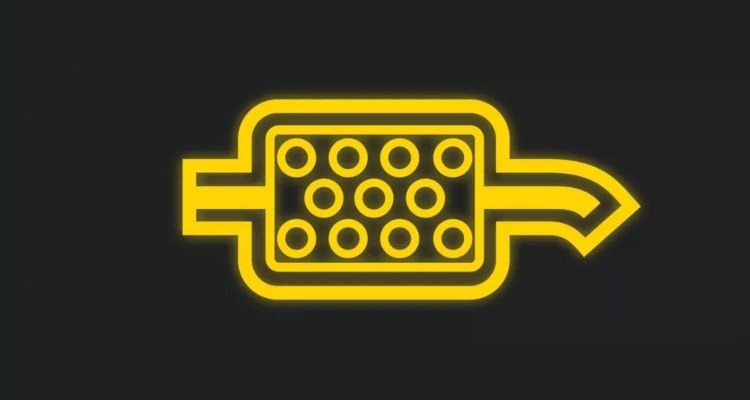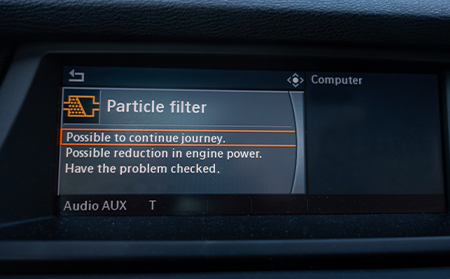Seeing that dreaded DPF light illuminate on your dashboard can be a cause for concern for any diesel car owner. But don’t panic! Understanding what the DPF light means, its causes, and how to prevent it from becoming a major issue is crucial.
In this blog, we’ll demystify the DPF light and provide practical advice to keep your diesel engine running smoothly.
What is a DPF on a Car?
A DPF, or Diesel Particulate Filter, is a component fitted to the exhaust system of diesel cars to reduce harmful emissions. It works by trapping soot particles produced by the engine, preventing them from being released into the atmosphere.
To avoid clogging, the DPF undergoes a regeneration process where the trapped soot is burned off at high temperatures. Regular longer journeys help to ensure this process occurs efficiently, but frequent short trips can lead to DPF issues.
What causes the DPF to become blocked?
When the deposits of soot build to a certain level, the car’s engine control unit starts what is known as ‘passive regeneration’. More fuel is injected into the engine, which raises the temperature in the exhaust system. This burns the soot, turning it into fine ash and expels it through the exhaust.
Your car usually performs this process whilst travelling at higher speeds, as this is required to maintain a high temperature in the exhaust system.
However, if you spend most of your time doing small trips around town, rarely reaching motorway speed, your car cannot perform this regeneration process. This causes the soot to continue to build up in the DPF, eventually causing the diesel particulate filter light to become illuminated.

Can a Blocked DPF Fail MOT?
A blocked DPF can indeed cause an MOT failure. If the DPF is completely blocked, it can significantly impact the car’s emissions, leading to an automatic fail.
Even if it’s partially blocked, excessive emissions might still result in a failed test. It’s important to note that while some garages offer DPF removal as a solution, this is illegal and will invalidate your car’s type approval.
To avoid these issues, regular long journeys and the use of DPF cleaning additives are recommended. If you’re concerned about your DPF, it’s advisable to have it checked by a qualified mechanic.
Is it Illegal to Remove a DPF?
Removing a DPF from a diesel car is illegal in the UK. This is due to the significant impact it has on air quality.
DPFs are designed to capture harmful soot particles, and removing them results in increased emissions. If caught driving a vehicle without a DPF, you could face a hefty fine of up to £1,000 for cars and £2,500 for vans.
Additionally, removing the DPF can void your car’s warranty and insurance, leaving you with potentially costly repairs and no financial protection in case of an accident.
What do you do when you see the DPF light?
When the DPF light has become illuminated, it’s telling you that ‘passive regeneration’ has failed and that you need to actively regenerate the diesel particulate filter.
You can do this by increasing your speed to more than 40mph for between 10 and 15 minutes. This should allow the exhaust to reach sufficiently high temperatures to burn the soot and clear the filter.
During the regeneration, you may notice things like your engine making an unusual noise, a slightly pungent smell coming from the exhaust and an increase in your fuel consumption. This should all return to normal once the active regeneration process has been completed. You should also see the DPF light go out.
If you cannot maintain a speed of more than 40mph for long enough to allow the regeneration process to complete, the soot will continue to build up in your filter and your DPF warning light will remain on until you have the problem fixed.
How long can you drive with the DPF light on?
Technically yes, but we would not recommend it. If you ignore the DPF light and continue driving, the build-up of soot will soon reach a point whereby your car has to enter ‘limp-home’ mode in order to prevent any damage to the engine.
This will probably result in other warning lights becoming illuminated, advising you to take your car to your local garage for diagnosis.
Your garage should be able to perform a forced DPF regeneration, which should clear the filter and allow it to function properly once more. However, it’s not a guaranteed fix, especially if the filter itself has become damaged or any other damage has been done to the engine. More serious repairs could run into the thousands, depending on the damage and the vehicle.
It really isn’t worth ignoring the DPF light.
How to Avoid DPF Problems:
- Regular long journeys: These allow the DPF to reach the high temperatures needed for regeneration.
- Avoid short journeys: Frequent short trips can prevent the DPF from reaching the necessary temperature for regeneration.
- Use the correct engine oil: Using the wrong oil can lead to DPF issues.
- Regular servicing: Adhere to the manufacturer’s service schedule, including replacing filters and fluids.
- Use a DPF cleaner: These additives can help prevent soot buildup.
- Gentle acceleration: Avoid harsh acceleration, as this can increase soot production.
- Check engine oil levels: Low oil levels can interfere with the regeneration process.
- Be aware of DPF warning lights: If the DPF light comes on, address the issue promptly.

By following these tips, you can significantly reduce the risk of DPF problems and keep your diesel car running smoothly. If your service is due soon, consider combining a DPF filter replacement with your routine maintenance.
For immediate assistance with DPF issues, don’t hesitate to contact us on 01405 801801. Our team is ready to help diagnose and resolve any DPF-related problems you may be experiencing.
If you would like to find out about other warning lights, make sure you read our Dashboard Warning Lights Explained guide.